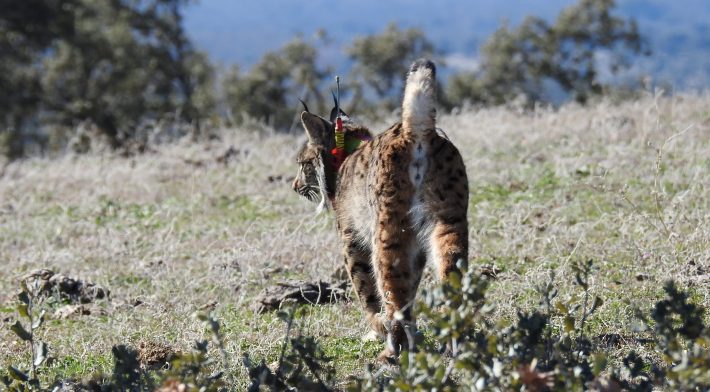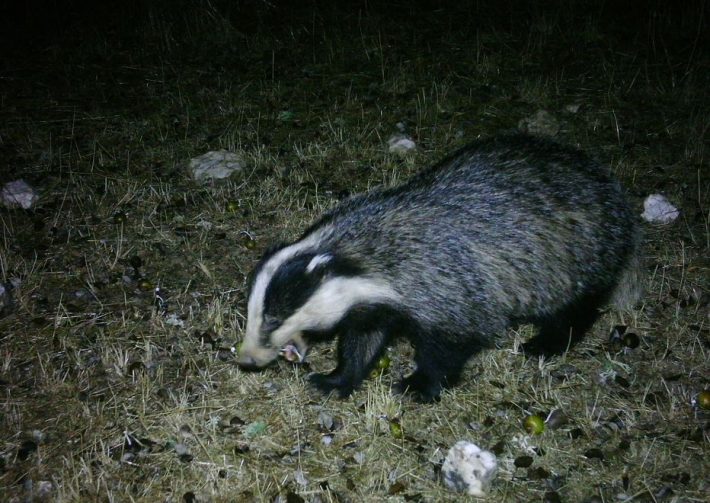Rewilding apex predators can limit the seed dispersal by frugivorous carnivores
King Juan Carlos University press release.
New research finds the reintroduction of the Iberian lynx in Southern Spain could be limiting fruit dispersal from smaller carnivores as a consequence of the perceived predation risk.

Many mammal carnivores play a key role in ecosystem functioning as agents of seed dispersal, by consuming a great quantity and variety of fleshy-fruits due to their generalist and opportunistic diet. Nevertheless, a new research article published in Journal of Animal Ecology, found that a scenario of apex predator restoration in Southern Spain could lead to medium-sized carnivores to be less efficient fruit consumers as consequence of the perceived predation risk.
Large carnivores have been frequently extirpated from many ecosystems worldwide as consequence of human persecution or the loss of their habitats and food resources. However, a rewilding process is leading to the recovery of their distribution ranges. Apex predators are at the top of trophic chains and can lead to the so called, top-down effects, this is the modification on the abundance and behaviour of species from lower trophic levels, critically influencing ecosystem structure and functions, what is known as a ‘trophic cascade’.
We were able to assess more accurately the effects of reintroducing large predators on key ecosystem services, such as the seed dispersal.
A new study lead by researches of the King Juan Carlos University (Madrid, Spain) reveals a potential trophic cascade from the Iberian lynx, the largest regional predator in Southern Spain, to a fleshy-fruit plant mostly dispersed by carnivores, the Iberian pear.
The research is based on an experimental design using camera-trapping, comparing the feeding behaviour on pear fruits by frugivorous carnivores which coexist with the Iberian lynx and individuals which inhabit outside of the lynx distribution range in Sierra de Andújar Natural Park (Southern Spain). This protected area is home of one of the largest Iberian lynx population in the world and was the last refugee together with Doñana for the species when it was near extinction.
Tamara Burgos, the lead author of the article highlights that “although the study area does not count with lynx reintroduced populations, the heterogeneous distribution of the Iberian lynx throughout the Natural Park offered us a unique opportunity to develop this experimental study in similar areas that differ each other only in the presence/absence of lynx. We were able to assess more accurately the effects of reintroducing large predators on key ecosystem services, such as the seed dispersal”.
Although this feline has expanded its distribution range over the last 20 years owing to conservation efforts from several LIFE projects “the Iberian lynx is still threatened and we should not lower our guard. The urgent and useful conservation measures and captivity breeding programs have born their fruits but the non-reintroduced populations still need attention, mainly because the lack of natural prey for this predator, the European rabbit” as states Emilio Virgós, author of this study and head of the research lab at King Juan Carlos University.

Lynx reduces the abundances of some frugivorous carnivores
The study shows that 70% and 100% of fox and stone marten visits, respectively, occurred in pear trees located outside of Iberian lynx territories. Moreover, the researchers identified less than half different fox individuals visiting pear trees in areas with presence of lynx compared to areas without lynx. Foxes and martens can be easily predated by a larger competitor and the predation risk perceived inside of lynx ranges could lead them to use more intensively surrounding areas to avoid conflictive encounters with lynx.
Large predators often control population abundances of smaller predators by direct killing or other types of competitive interactions by shared resources. However, the badger did not seem to show sensitivity to lynx presence, probably due to their larger size and corpulence, in line with what previous studies found.
Foxes eat less fruit and modify their foraging behaviour inside of lynx ranges
The red fox was the carnivore which overall consumed more Iberian pear fruits, however consumed 38% less fruit within lynx ranges in comparison with foxes which inhabited areas without lynx. Foxes which co-existed with lynx turned into less efficient frugivores, by consuming less fruit per unit of time and making shorter visits to pear trees, both behavioural features typically linked to an anti-predatory response.
Nevertheless, “the badger could balance the loss of seeds dispersed by foxes within lynx ranges in areas where they reach greater densities, as occurs in some areas of Doñana, where Iberian pear seeds are mostly dispersed by badgers” as states Jose Fedriani, another author of this study from the Center of Desertification Research (CIDE-CSIC).
Implications of trophic cascades on plant ecology
Carnivores were not the only frugivores consuming pear fruits, however most of the other animals involved were low quality dispersers leading to broke the seed during mastication, such as deer. Therefore, the red fox is the main seed disperser for the Iberian pear in the study area and the lack of this seed disperser could alter the demography and spatial structure of this scarce fruit tree. In a broader frame, fleshy-fruited plants dispersed by medium-sized mammals could experience limitations of their seed dispersal due to trophic cascades triggered by reintroduced large predators.
“Although we have assessed these alterations on the frugivory behaviour at local scale, we encourage rewilding programs consider trophic cascades as a powerful mechanism, which can alter key ecosystem functions in contrasting ways” concludes Tamara Burgos.
You can read the full article here:
https://besjournals.onlinelibrary.wiley.com/doi/10.1111/1365-2656.13682
Like what we stand for?
Support our mission and help develop the next generation of ecologists by donating to the British Ecological Society.